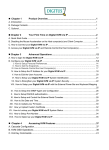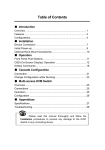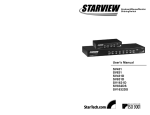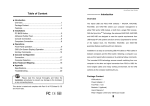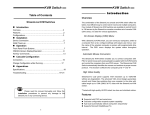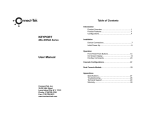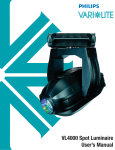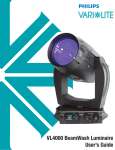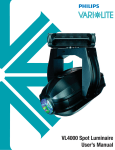Download Digitus DS-11210 KVM switch
Transcript
DIGITUS® KVM Switch Modules ■ Introduction Overview… … … … … … … … … … … … … … … … … … … … … … … … … … .… .1 Package Content… … … … … … … … … … … … … … … … … … … … … … ...… .4 Features… … … … … … … … … … … … … … … … … … … … … … … … … … … ...5 Configurations… … … … … … … … … … … … … … … … … … … … … … … … .… 7 ■ Installation Cables … … … … … … … … … … … … … … … … … … … … … … … … … … … … .9 Device Connection… … … … … … … … … … … … … … … … … … … … … ..… .10 Initial Power-up… … … … … … … … … … … … … … … … … … … … … … … .… 13 ■ Operation Push Buttons… … … … … … … … … … … … … … … … … … … … … … … … .… 14 OSD (On-Screen Display) Operation… … … … … … … … … … … … … … ....15 Hotkey Commands… … … … … … … … … … … … … … … … … … … … … ......21 ■ Cascade Configuration Connection… … … … … … … … … … … … … … … … … … … … … … … … … ....24 Change Configuration while Running… … … … … … … … … … … … … … … 25 ■ Sun/Mac Keyboard Mapping ■ Appendices Specifications… … … … … … … … … … … … … … … … … … … … … … … ..… ..27 Troubleshooting… … … … … … … … … … … … … … … … … … … … … … … ....29 Please read this manual thoroughly and follow the Installation procedures to prevent any damage to the DIGITUS® or any connecting device. RoHS DIGITUS® KVM Switch Module for modular based TFT consoles Note: When connected to the LCD Console Drawer, the console port of the KVM Switch Module is not applicable. 1 DIGITUS® KVM Switch Module for modular based TFT consoles ------------------------ Introduction Overview The combination of DIGITUS® Console Drawer and DIGITUS® KVM Switch Module offers the latest and the most efficient way of controlling server rooms and multiple computers. Many DIGITUS® KVM Switch Modules are available to control from 8 to 136 servers by the DIGITUS® Console Drawer or another set of console 100ft (30m) away; it is the ultimate tool for server management. There are many types of DIGITUS® KVM Switch Modules with different computer interfaces available: l Hybrid “PS/2 + USB” Modules with PS/2 keyboard, PS/2 mouse, USB (keyboard + mouse) and monitor (HDB15), as shown in Figures below. To To computer PS/2 and USB Connection 2 DIGITUS® KVM Switch Module for modular based TFT consoles To console DS-11210 PS/2 and USB Connection l Slim PS/2 Modules with special 1-to-3 connectors for PS/2 keyboard, mouse and monitor (HDB15). (IMM) Slim PS/2 1-to-3 Connectors and Cables (IUM) Slim USB+PS/2, 1-to-2 / 1-to-3 Connectors and Cables 3 DIGITUS® KVM Switch Module for modular based TFT consoles Module Hybrid Slim DS-11210 For Computer Interface USB + PS/2 DS-13210, DS-14210 USB + PS/2 Product On-Screen Display (OSD) Menu With an DIGITUS® KVM Switch Module, you can name your computers, switch to a computer from a list, configure settings with easy-to-use menus, view the name of the selected computer on-screen with programmable time interval. The OSD menu displays the system status throughout operation. High Video Quality DIGITUS®'s LCD panel supports VGA resolution up to 1024x768 for 15”LCD panel or 1280 x 1024 for 17”and 19”LCD panel without any degradation. The advanced VGA circuit design guarantees smooth and flicker-free switching from one computer to the other with VGA cable length up to 100ft (30 meters)*. *Tested with high-quality UL2919-rated, low-loss and shielded cables. 4 DIGITUS® KVM Switch Module for modular based TFT consoles Package Content KVM Switch x 1 Bracket x 2 (For 8/16-port modules only) User’ s Manual x 1 Screws x 1 pack * Power Adapter is come with the LCD Console Drawer Packaging, NOT with this packaging. 5 DIGITUS® KVM Switch Module for modular based TFT consoles General Features n Cascade configuration expands system capability n Auto-scan automatically selects computers sequentially n Supports most of mice such as Microsoft IntelliMouse (Pro), Explorer, Optical, and so on n Assign computers with unique and meaningful names n Identify and select computers by the names n Programmable scan filters unused computers n Store system settings and name entries to non-volatile memory n Password security locks computer from unauthorized access n Gain complete control with easy-to-use OSD interface n Hotkey functions allow easy computer access n Keyboard states automatically saved and restored when switching computers n Operating system independent, transparent to all applications n Plug and play system configuration n Keyboard and mouse can be hot plugged at any time n DDC2B compatible n Supports optional multimedia Module for microphones and stereo speakers n Cascadable to all 19”rack mountable PS/2 KVM Switches n (Optional) The Built-In Power is available for certain modules. n Manage multiple computers from two locations (For multi-access modules only ) 6 DIGITUS® KVM Switch Module for modular based TFT consoles Features for Hybrid “USB + PS/2”KVM Switch Module DS-11210 l Supports computers with either PS/2 or USB interface l Supports Sun servers, HP servers and Mac Features for Slim “USB + PS/2” KVM Switch Modules DS-13210, DS-14210 l Unique loose-free, 1-to-3 / 1-to-2 cables save spaces, ideal for computers with PS/2 or USB interfaces, such as PC, USB-Sun and USB-Mac. 7 DIGITUS® KVM Switch Module for modular based TFT consoles Configurations DIGITUS® KVM Switch Modules are available for 8, and 16 ports with various interfaces. For the applications of requiring many computers, DIGITUS® KVM Switch Modules can be cascaded in a master/slave configuration. Single DIGITUS® KVM Switch Module Configuration Combined with an DIGITUS® Console, the DIGITUS® KVM Switch Module can be connected to multiple computers with keyboard, mouse, and monitor cables as shown below. A Single DIGITUS® KVM Switch Module Configuration 8 DIGITUS® KVM Switch Module for modular based TFT consoles DIGITUS® KVM Switch Module in cascade (Master/Slave) Configuration You can connect a second level of one or more DIGITUS® KVM Switch Modules to a Master unit. Cascade configuration expands system ability, allowing you to select computers connected to the Master or Slaves. There is only one Master that connects to the DIGITUS® Console directly operated by a user. Once connected, DIGITUS® KVM Switch Modules automatically configure themselves to either Master or Slave. Slaves of different DIGITUS® KVM Switch Modules can be mixed in cascade configuration. A Cascade DIGITUS® Configuration Throughout this manual, Master is an DIGITUS® KVM Switch Module that connects directly to the drawer. And, Slave is an DIGITUS® KVM Switch Module that has its CONSOLE port connected to a Master's “PC x”port. Slave only exists in cascade configuration. 9 DIGITUS® KVM Switch Module for modular based TFT consoles ------------------------ Installation Cables Using the following cables to connect computers with PS/2 interface. 1-to-3 cable for PS/2 Computers 3-to-3 cable for PS/2 Computers Using the following cables to connect computers with USB interface. 2-to-2 cable for USB Computers 1-to-2 cable for USB Computers 10 DIGITUS® KVM Switch Module for modular based TFT consoles Device Connection l Hybrid “PS/2 + USB”Module I. DS-11210 You can only connect to a computer using either PS/2 or USB port. -- To a USB Computer: Connect the standard VGA cable and a USB A-B cable to the computer and DS-11210 as shown in Figure A. The computer can be a USB-ready PC, Sun, HP server, or a Mac. Figure A: DS-11210 with USB Computer Connection Diagram n To a PS/2 Computer: Connect the standard VGA cable and two mini-DIN6 male-to-male cables to the computer and DS-11210, see Figure B. There are two mini-DIN6 female connectors marked with keyboard and mouse, be sure not to swap the connections. 11 DIGITUS® KVM Switch Module for modular based TFT consoles Figure B: DS-11210 with PS/2 Computer Connection Diagram -- To a Laptop Computer: In most cases, all you need is one VGA cable and one USB A-B connected between the DS-11210 and your laptop; however, some laptop computers do not follow industry standard, please check your laptop user's manual for details. -- To a KVM Switch: with cascading with a KVM switch, the DS-11210 can control up to 16 computers. The connection is exactly the same as Figure A or Figure B shown, the only difference is connect to the “CONSOLE PORT”(could be “PS/2”or “USB”interface) of KVM switch instead of computer. NOTE: PLEASE CHOOSE EITHER “PS/2” OR “USB” TO CONNECT BEFORE TURNING ON YOUR COMPUTER. 12 DIGITUS® KVM Switch Module for modular based TFT consoles Slim Modules DS-13210, DS-14210 Use only the special cables as shown below. l 1-to-2 Cable For USB Computers DS-1921x 1-to-3 Cable For PS/2 Computers DS-1911x Connection from a Slim DIGITUS® KVM Switch Module to a PS/2 computer or a USB computer is shown below. (For IUM- modules only) Connections for the Special Cables 13 DIGITUS® KVM Switch Module for modular based TFT consoles A Module as a Slave or a Stand-alone KVM Switch A slave DIGITUS® KVM Switch Module (see Cascade Configuration chapter) may be mounted to the rear vertical poles inside a rack cabinet by the rear brackets with connectors to computers facing rear, as shown below. Slave DIGITUS® KVM Switch Module and Rear Bracket Attachment The connectors (keyboard and mouse) at the Local port on the rear of the KVM Module are not applicable when the Module is connected to the TFT LCD drawer by the C-36 connector. When the C-36 connector is not connected to the TFT LCD drawer, the DIGITUS® KVM Switch Module acts as a rear-mount stand-alone KVM Switch Module. The VGA ports at the Local and Remote can be connected to external VGA monitors at any time. Initial Power-Up Make sure all computers and DIGITUS® KVM Switch Modules are powered down during the installation. You must power up the Master DIGITUS® before turning on any other devices. n For single DIGITUS® KVM Switch Module: 1) 2) n Apply the proper power to the Master. Turn on computers. For cascaded DIGITUS® KVM Switch Module: 1) 2) Apply the proper power to the Master. Apply the proper power to all Slaves. 3) Turn on computers. Note: You may hot plug additional powered-down computer or a slave DIGITUS® KVM Switch Module without turning any existing DIGITUS® or computer off after initial power up. 14 DIGITUS® KVM Switch Module for modular based TFT consoles ------------------------ Operation Push-Buttons A computer may be selected by pressing the push button directly, by issuing hotkey commands or by activating the OSD window. The indicator changes to reflect the computer port selected (red). The indicator flashes red when it is in either Auto Scan or Manual Scan mode. Note: For 16-port Modules: 1 ~ 8 represent the lower 8 ports and A ~ H for the higher 8 ports. Push the same button twice for higher 8 ports, for example, push button 1 twice for port A, and so forth. OSD menu and hotkeys are available for computer selection. n K/M RESET K/M RESET solves most problems developed by keyboard, mouse, device replacement, or change of configuration. Press down both the front-panel number 1 and 2 push-buttons for 2 seconds to re-configure the whole system without turning either the DIGITUS® KVM Switch Module or any computer off. n AUTO SCAN DIGITUS® KVM Switch Module provides an easy to use feature to start Auto Scanning. You can press down both the front-panel number 7 and 8 buttons for 2 seconds to start Auto Scanning. For 4-port modules, press number 3 and 4 instead. 15 DIGITUS® KVM Switch Module for modular based TFT consoles OSD (On-Screen-Display) Operation Figure C: OSD Screen Illustration Only Hybrid Module offers F5, see Function key F5 By hitting the left Ctrl key twice within two seconds, you may see the 'Hotkey Menu' if it is enabled (an OSD option). Or, by hitting the left Ctrl key three times within two seconds, you will see a 'KVM MENU' screen showing a list of the computers with corresponding port numbers, names and status, see Figure C. The port number of the currently selected computer is displayed in red, same as the front indicator, at the right corner of the OSD menu. The color of a device name is green if it has power and is ready for operation, or the color is white as it has no power. OSD menu updates the color when it is activated. Pressing the PageUp and PageDown keys to view 8 other computers. Use the “é “, “ê “, “ 1 “~ “ 8 “or “ A “~ “ H “to highlight a computer and the ENTER key to select it. Or, you may press ESC to exit OSD and remove the OSD menu from the display; the status window returns to the display and indicates the currently selected computer or operating status. A triangle mark (4) to the right of a name indicates the port is cascaded to a Slave; 16 DIGITUS® KVM Switch Module for modular based TFT consoles the number at the left of the triangle mark shows the number of ports the Slave has, i.e. 84for an 8-port Switch. ENTER key brings you one level down and another screen pops up listing the names of the computers on that Slave. The name of the Slave will be shown at the upper right corner of the OSD menu. It is useful to group computers and still be able to see the group name. An eye mark (N) to the right of a name indicating the computer is selected to be monitored in Scan mode. In OSD, this mark can be switched on or off by function key F2 . Press ESC key to exit OSD and to return to the selected computer; the computer name is also shown on the screen. =Function key F1 : To edit name entry of a computer or a Slave with up to 14 characters. First, highlight a port then press <F1> followed by name entry. Valid characters are ‘ A’ ~’ Z’ , ‘ 0’ ~’ 9’and the dash character. Lowercase letters are converted to uppercase ones. Press BACKSPACE to delete a letter one at a time. Non-volatile memory stores all name entries until you change, even if the unit is powered down. =Function key F2 : To switch the eye mark (N) of a computer on or off. First, use the é and ê arrow keys to highlight it, and then press F2 to switch its eye mark on or off. If Scan Type is ‘ Ready PC +N', only the power-on and eye mark selected computers will be displayed sequentially in Scan mode. =Function key F3 : To lock a computer from unauthorized access. To lock a device, highlight it then press F3 . Now, enter up to 4 characters (‘ A’ ~’ Z’ , ‘ 0’ ~’ 9, ‘ -‘ ) followed by ENTER as new password. A Security-enabled device is marked with a lock (Ï) following its port number. To permanently disable the security function from a locked device, highlight it, press F3 then enter the password. If you want to access the locked device temporarily, simply highlight it and press ENTER , the OSD will ask you for the password. After entering the correct password, you are allowed to use the device. This device is automatically re-locked once you switch to another port. During Scan mode, OSD skips the password-protected devices. =Function key F4 : More functions are available by hitting F4 . A new screen pops up displaying more functions as described below. Most of them are 17 DIGITUS® KVM Switch Module for modular based TFT consoles marked with a triangle (4) indicating there are options to choose from. Using the “ é ” and “ ê “ arrow keys, select the functions and press ENTER . Available options will be shown in the middle of the screen. Again, using the “é ” and “ê “ arrow keys to view options then press ENTER to select it. You can press ESC to exit at any time. n Auto Scan In this mode, the DIGITUS® automatically switches from one power-on computer to the next sequentially in a fixed interval. During Auto Scan mode, the OSD displays the name of the selected computer. When Auto Scan detects any keyboard or mouse activity, it suspends the scanning till activity stops; it then resumes with the next computer in sequence. To abort the Auto Scan mode, press the left Ctrl twice, or, press any front button. Scan Type and Scan Rate set the scan pattern. Scan Type ( F4 :More\Scan Type) determines if scanned computers must also be eye mark selected. Scan Rate ( F4 :More\Scan Rate) sets the display interval when a computer is selected before selecting the next one. n Manual Scan Scan through power-on computers one by one by keyboard control. Type ( F4 :More\Scan Type) determines if scanned computers must also be eye mark selected. Press the up arrow key “é ”to select the previous computer and the down arrow key “ ê ” to select the next computer. Press any other key to abort the Manual Scan mode. n Audio Stick An optional multimedia Module can be LINKed to the back of each DIGITUS® KVM Switch Module for selecting microphone and stereo speaker signals. There are two options for Audio Stick: ON and Off. When set to 'On', audio selection follows computer selection. When set to 18 DIGITUS® KVM Switch Module for modular based TFT consoles 'Off', audio selection stops following computer selection. It is useful if you want to listen to a particular computer's audio signal while operating other computers. The non-volatile memory stores the Audio Stick setting. n Scan Type Ready PC +N: In Scan mode, scan through power-on and eye mark selected computers. Ready PC: In Scan mode, scan through power-on computers. N Only: In Scan mode, scan through any N selected computer regardless of computer power status. The non-volatile memory stores the Scan Type setting. n Scan Rate Sets the duration of a computer displayed in Auto Scan mode. The options are 3 seconds, 8 seconds, 15 seconds, and 30 seconds. The non-volatile memory stores the Scan Rate setting. n PS/2 Keyboard Speed DIGITUS® offers keyboard typematic setting that overrides the similar settings in BIOS and in Windows. Available speed options are Low, Middle, Fast, and Faster as 10, 15, 20, and 30 characters/sec respectively. The non-volatile memory stores the Keyboard Speed setting. n Hotkey Menu When you hit the left Ctrl key twice within two seconds, the "Hotkey Menu" appears displaying a list of hotkey commands if the option is On. The 'Hotkey Menu' can be turned Off if you prefer not to see it when the left Ctrl key is hit twice. The non-volatile memory stores the Hotkey Menu setting. n CH Display Auto Off: After you select a computer, the port number and name of the computer will appear on the screen for 3 seconds then disappear automatically. Always On: The port number and name of a selected computer and/or OSD status displayed on the screen all the time. The non-volatile memory stores the CH Display setting. 19 DIGITUS® KVM Switch Module for modular based TFT consoles n Position The position of the selected computer name and/or OSD status is displayed on screen during the operation. The actual display position shifts due to the different VGA resolution, the higher the resolution the higher the display position. The non-volatile memory stores the Position setting. Upper Left, Upper Right, Lower Left, Lower Right. Middle. n Country Code for Sun <For Slim USB+PS/2 and Hybrid USB+PS/2 Modules only> Sun keyboards of different languages have different layouts. The DIGITUS® KVM Switch Module is able to emulate a Sun keyboard for a specific language type (or country: Arabic, Belgian … US, Yugoslavia). Select the proper country code that matches ALL of your Sun computers. n Max. Resolution <For Slim USB+PS/2 and Hybrid USB+PS/2 Modules only> You can adjust the monitor resolution under this sub-menu. There are the following selections: 1024 x 768, 1280 x 1024, 1360 x 768 and “DDC2B Disable”. Please check your PC’ s Maximum Resolution before you adjust it. Note: The 16:9 LCD Panel and 16:10 LCD Panel are not applied =Function key F5 : <For Slim USB+PS/2 and Hybrid USB+PS/2 Modules only> To switch the Sun mark of a port on or off indicating the computer is a Sun server as shown in figure below. Sun servers have more keys on the keyboard than a PC. When a Sun-marked port is selected, the KVM Switch starts to translate the keys from a PS/2 keyboard to a Sun keyboard. See Sun Keyboard Mapping for details. 20 DIGITUS® KVM Switch Module for modular based TFT consoles OSD Screen for USB+PS/2 Module and the Sun Mark = ESC : To exit the OSD, press the ESC key. Hotkey commands Hotkey command is a short keyboard sequence to select a computer, to activate computer scan, etc. DIGITUS® interprets keystrokes for hotkeys all the time. A hotkey sequence starts with two left Ctrl keystrokes followed by one or two more keystrokes. A built-in buzzer generates a high-pitch beep for correct hotkey command; otherwise, one low-pitch beep for error and the bad key sequence will not be forwarded to the selected computer. The short form hotkey menu can be turned on as an OSD function ( more\Hotkey Menu) every time the left Ctrl key is pressed twice. F4 : L-Ctrl: is the Ctrl key located at the left side of the keyboard. 1~8/A~H: are the number keys '1' ~ '8' at the upper row of the keyboard and character keys 'A' ~ 'H' case insensitive. Do not use the keypad at the right of the keyboard. 21 DIGITUS® KVM Switch Module for modular based TFT consoles g To select a computer by hotkey command, you must know its port number, which is determined by the DIGITUS® KVM Switch Module connection. For a computer connected to a Master, its port is represented by the PC port label (1~8 or A~H). For a computer connected to a Slave, two characters represent its port. The first character is the port number of the Master unit (1~8) and the second one is the port number of the Slave (1~8 or A~H). Please note that only Master's 'PC 1' ~'PC 8' ports can be connected to a Slave. Left Ctrl + left Ctrl + 7 Selects a computer connected to port 7 of the Master. Left Ctrl + left Ctrl + 6 + C Selects a computer connected to port C of a Slave connected to port 6 of the Master. g To start Auto Scan, automatically scan power-on computers one by one at a fixed interval: Left Ctrl + left Ctrl + F1 When Auto Scan detects any keyboard or mouse activity, it suspends the scanning till activity stops; it then resumes with the next computer in sequence. The length of the Auto Scan interval (Scan Rate) is adjustable, see below. To abort the Auto Scan mode, press the left Ctrl key twice. Note: Scan Type determines whether an eye-marked computer is to be displayed during Auto Scan. g Manual Scan enables you to manually switch back and forth between power-on computers. Left Ctrl + left Ctrl + F2 Press “é ”or “ê ”to select the previous or the next computer in sequence. And, press any other key to abort the Manual Scan. Note: Scan Type determines whether an eye-marked computer is to be displayed during Auto Scan. g To adjust Scan Rate, setting the duration before switching to the next computer in Auto Scan: Left Ctrl + left Ctrl + F3 The DIGITUS® sends one to four beeps indicating scan interval of 3, 8, 15, and 30 seconds respectively. g To adjust keyboard typematic rate (characters/sec), this setting over-rides that of 22 DIGITUS® KVM Switch Module for modular based TFT consoles BIOS and any operating system: Left Ctrl + left Ctrl + F4 The DIGITUS® generates 1 to 4 beeps corresponding to 10, 15, 20, and 30 characters/sec respectively. g Audio Stick An optional multimedia Module can be LINKed to the back of each DIGITUS® for selecting microphone and stereo speaker signals. There are two options for Audio Stick: ON and Off. When set to 'On', audio selection follows computer selection. When set to 'Off', audio selection stops following computer selection. It is useful if you want to listen to a particular computer's audio signal while operating other computers. Left Ctrl + left Ctrl + F5 The DIGITUS® generates 1 or 2 beeps corresponding to On and Off respectively. 23 DIGITUS® KVM Switch Module for modular based TFT consoles -------------------- Cascade Configuration Connection Before connecting a device (a computer or a Slave KVM Switch Module) to the Master DIGITUS® KVM Switch Module under power, you must turn off the device. Note: The Master must have equal or more 'PC x' ports than that of the Slave, i.e., if DS-13210 is the master, DS-13210 can be a Slave, but not the DS-14210. The ports labeled "PC 1"~”PC 8”can be connected to either a computer or a Slave's LOCAL (or CONSOLE) port, as shown below. The ports “PC A"~”PC H”can only be connected to computers. Slave Console Connection Note: Only Master’ s PS/2 PC ports (not USB ports) can be connected to a Slave’ s LOCAL (or CONSOLE) port for cascade application. The maximum number of computers controlled by a master/slave configuration with all 8-port units is 64 -- with 8 Slaves and each Slave connects to 8 computers, see figure below. 24 DIGITUS® KVM Switch Module for modular based TFT consoles Cascaded 8-Port DIGITUS® KVM Switch Modules For OSD menu: After connection completes, you should re-activate the OSD menu to check if the Master recognizes the Slaves. A triangle mark (4) is placed to the right of the channel name indicating the port is connected to a Slave not a computer. A number to the left of the triangle mark indicates the Slave Module, i.e. 84 for an 8-port Switch Module. Change Configuration while Running A device (a computer or a KVM Switch Module) at any 'PC x' port can be changed at any time after initial power-up. If you change any one of the “PC 1”to “PC 8”ports connection from a computer to a Slave or vice versa, or replace the devices of a port; the OSD will update this change the next time it is activated. Note: Any new device must be turned off before it is connected to the Master. 25 DIGITUS® KVM Switch Module for modular based TFT consoles --------------- Sun/Mac Keyboard Mapping The KVM modules emulate a Sun’ s keyboard and mouse when a computer is marked with a Sun in OSD menu by Function key F5 . A Sun keyboard has more keys than a standard PS/2 one. These extra keys are simulated by tapping the lower-right Ctrl followed by one of the function keys on a PS/2 keyboard (i.e. combo key). For instance, tap the lower-right Ctrl key, then tap the function key F7 to activate Open for a Sun computer. From Map to Map to PS/2 keyboard Sun keyboard Mac keyboard right - Ctrl 1 right - Ctrl 2 right - Ctrl 3 right - Ctrl 4 right - Ctrl F1 Stop right - Ctrl F2 Again right - Ctrl F3 Props right - Ctrl F4 Undo right - Ctrl F5 Front right - Ctrl F6 Copy right - Ctrl F7 Open right - Ctrl F8 Paste right - Ctrl F9 Find right - Ctrl F10 Cut note v power Print Screen F13 Scroll Lock F14 Pause Break right - Ctrl right left - F15 H Help right - ¨ right - left - ¨ left - Compose right - Alt Alt Graph right - Option left - Alt Alt left - Option Note: For Sun: The switch Module does not support LowPower option under Power Off Select after the command right – Ctrl 4 . * For Japanese keyboard: The leading key for the Combo Key is replaced by. 26 DIGITUS® KVM Switch Module for modular based TFT consoles Hybrid Modules User port number Computer port number Cascade control PC number Hybrid DS-11210 N/A 1 Up to 16* Cable type 2-to-2 / 3-to-3 Cable Applicable to computer On-screen display (OSD) Push button control Hot plug-and-play Rack-mounted Automatic scan interval Programmable scan pattern PS/2 PC, Sun**, Mac N/A N/A Yes Yes, 19” industry-standard N/A N/A 30M (100ft) at CONSOLE 30M (100ft) at PC ports for PS/2 5M at PC ports for USB 1920 x 1440, DDC2B C-36 Specifications Cable length (Max) VGA resolution TFT LCD KVM drawer connector Keyboard ** Computer mouse ** connector monitor Keyboard Console mouse connector monitor H x W x D (mm) (in.) Rear-mount brackets Size Power supply (min) PS/2 x 2, USB x 1 HDB15 male x 1 N/A N/A N/A 40x404x114 1.6x15.9x4.5 1U-height, included 1U 9 ~ 12V DC, 500mA *** * Maximum control when cascaded with modules of the same type. ** For USB-ready Sun computers. *** Without connecting the LCD console drawer, the power supply needs not less than 500mA. With connecting the LCD console drawer, the power supply will be between 3.0A and 4.2A with the voltage of 12V DC based on the size of LCD panel, for example, the 15” LCD console drawer with the module will need the power supply not less than 3.0A. 27 DIGITUS® KVM Switch Module for modular based TFT consoles Slim Modules Specifications Slim USB+PS/2 DS-13210 DS-14210 User port number 1 1 Computer port number Cascade control PC number 8 16 Up to 64* Up to 136* Cable type 1-to-3 / 1-to-2 Cable Applicable to computer PS/2 PC, Sun**, Mac On-screen display (OSD) Yes Push button control 8, available when connected to a KVM drawer ( 8/16 Port ) 4, available when connected to a KVM drawer ( 4 Port ) Hot plug-and-play Yes Hotkey control Yes Rack-mounted Yes, 19” industry-standard Automatic scan interval Programmable scan pattern 3, 8, 15, 30 seconds Cable length (Max) 30M (100ft) at CONSOLE 30M (100ft) at PC ports for PS/2 5M at PC ports for USB VGA resolution TFT LCD KVM drawer connector 1920 x 1440, DDC2B Computer connector Keyboard ** Mouse ** Monitor Console connector Keyboard Mouse Monitor 3 options available C-36 HDB15 female x 8 (gray) HDB15 female x 16 (gray) PS/2 PS/2 HDB15 female H x W x D (mm) (in.) 40 x 404 x 114 1.6 x 15.9 x 4.5 Rear-mount brackets 1U-height, included Size 1U Power supply (min) 9 ~ 12V DC, 500mA *** * Maximum control when cascaded with modules of the same type. ** For USB-ready Sun computers. *** Without connecting the LCD console drawer, the power supply needs not less than 500mA. With connecting the LCD console drawer, the power supply will be between 3.0A and 4.2A with the voltage of 12V DC based on the size of LCD panel, for example, the 15” LCD console drawer with the module will need the power supply not less than 3.0A. 28 DIGITUS® KVM Switch Module for modular based TFT consoles Troubleshooting Ensure that all cables are well seated. Check that keyboard/mouse cables are not swapped. Label and bundle the cables for each computer to avoid confusion when connected to the DIGITUS®. Symptom Possible causes Recommended solutions Nothing works. Bad connection at the Push the assembled drawer and the KVM C-36 connectors. Module box firmly together leaving only 8mm (5/16 inch) space in between. Be sure they are secured by two screws. VGA monitor works fine Another keyboard or If the C-36 connector on the KVM Module but keyboard and touch mouse is connected to box connects to a KVM drawer, its Local pad does not work. the rear side of the KVM console should not connect to any Module box (marked with keyboard or mouse. Local) when the C-36 connector is connected to the KVM drawer. Connection inside the Verify if the KVM drawer is bad by KVM drawer becomes disconnecting it from the KVM Module loose due to vibration. box (the C-36 connector is not connected). Connect a keyboard, mouse, and monitor to the Local port on the KVM Module box and another computer to any of the PC ports and use the KVM Module box as a stand-alone KVM Switch. The quality of video is Video card quality bad or the picture is grainy 1. Choose a colorful Desktop Wallpaper for the following adjustments. a. Press to bring up the OSD menu, select Color, and then select Auto Color. After done the Auto Color job, simple press to exit the OSD. b. Press and hold to run Auto Tuning for the optimal screen display. No screen image, or no A power-on computer is Turn on a computer and select it by the OSD menu not selected. front push-buttons. External power supply is Apply power to the system via the not connected, No power external power supply. Press the front to DIGITUS®. push buttons to select a computer. A red rectangle, part of the OSD function, should pop up displaying the port number as the system is properly powered. Connect a VGA monitor to the LOCAL port at the rear and check if the VGA signal presents. 29 DIGITUS® KVM Switch Module for modular based TFT consoles Unable to operate Incorrect KVM Module. USB-ready Sun server. Use only the hybrid PS/2 + USB KVM Module. Keyboard error on boot. Loose keyboard connection. Alphabets on the TFT Improper resolution LCD display are blur or settings. have shadows. I forget the password. Bad memory. Invoke the OSD menu, move the light bar to the port, press F5 to set the Sun mark on. Make sure keyboard cables are Well seated. Set the VGA resolution of the computers to 1024 x 768 with “Large Font” for the best performance. Consult the dealer. Memorize the password. Make sure slave’ s CONSOLE is connected to Master’ s PC 1~ PC 8 port. Only PS/2 ports can be used for cascade connection. Master/slave does not Improper installation work. procedures. Press and hold the 1 and push-buttons to initiate K/M reset. 2 Remove any possible power supply to the slave (unplug all cables), before connecting it to the Master. Press both SHIFT keys. Keyboard shifted. strokes The computer was in shifted state when last switched. The é and ê keys do All PCs are off or only one Turn computers on. not work in Manual PC is turned on. Scan Scan. mode works for power-on Press any other key to abort Manual Scan computers only. mode. Auto Scan does not switch PC and DIGITUS® beeps from time to time and red indicator flashes. Scan type is eye mark selected but no PC is eye mark selected in OSD. All PCs are off or only one PC is turned on. Scan mode works for power-on computers only. Set proper Scan type in OSD and determine which PCs are eye mark selected, do it in OSD. Turn on computers. Set proper Scan Type in OSD and determine which PCs are eye mark selected, do it in OSD. Scan type is eye mark selected but no power-up Press left Ctrl key twice to abort Auto PC is eye mark selected Scan mode. in OSD. Press any front button to select a PC, and Auto Scan stops. 30 DIGITUS® KVM Switch Module for modular based TFT consoles Double OSD images at Improper slave cascade configuration. connection procedure. Press push-buttons 1 and 2 down for 2 seconds to activate K/M RESET. Remove any possible power supply to the Slave (unplug all cables), before connecting it to the Master. OSD menu is not at the OSD menu has fixed Use F4 : More\Position to select UL or proper position. resolution and its size UR. OSD menu may appear near the varies as computer VGA middle of the screen when LL or LR is resolution changes. selected. Computer can not use Loose mouse adapter. Secure the mouse adapter to computer’ s serial mouse. COM port. Incorrect mouse adapter. Use only the mouse adapter comes with the unit. Incorrect PC port The mouse conversion is only effective at connection. PC ports 7 and 8. Can not select a Improper Master unit Only Master ports PC1~PC8 can be computer connected to connection. connected to slaves. a slave. Improper slave unit Connect slave CONSOLE port to connection. PC1~PC8 ports of the Master. Too many levels of slaves. Only one level of slave units is allowed. Pop up OSD again to check if Master recognizes the slave connection. Look for triangle mark and the number before it. The DIGITUS® fails to The system is not getting Make sure the external power supply is function occasionally. enough power properly connected. Limited Warranty IN NO EVENT SHALL THE DIRECT VENDOR'S LIABILITY FOR DIRECT OR INDIRECT, SPECIAL, INCIDENTIAL OR CONSEQUENTIAL DAMAGES, LOSS OF PROFIT, LOSS OF BUSINESS, OR FINANCIAL LOSS WHICH MAY BE CAUSED BY THE USE OF THE PRODUCT EXCEEDS THE PRICE PAID FOR THE PRODUCT. The direct vendor makes no warranty or representation, expressed or implied with respect to the contents or use of this documentation, and especially disclaims its quality, performance, merchantability, or fitness for any particular purpose. The direct vendor also reserves the right to revise or update the product or documentation without obligation to notify any user of such revisions or updates. For further information, please contact your direct vendor. All the brand names and registered trademarks are the property of their respective owners. 31 From Map to PS/2 keyboard Sun keyboard right - Ctrl 1 right - Ctrl 2 right - Ctrl 3 right - Ctrl 4 right - Ctrl F1 Stop right - Ctrl F2 Again right - Ctrl F3 Props right - Ctrl F4 Undo right - Ctrl F5 Front right - Ctrl F6 Copy right - Ctrl F7 Open right - Ctrl F8 Paste right - Ctrl F9 Find right - Ctrl F10 Cut right - Ctrl H right - note Help right - ¨ left - left - ¨ Compose right - Alt Alt Graph left - Alt Alt From Map to PS/2 keyboard Mac keyboard right - Ctrl 4 v power Print Screen F13 Scroll Lock F14 Pause Break F15 right - right - left – left - right - Alt right - Option left - Alt left - Option "

































